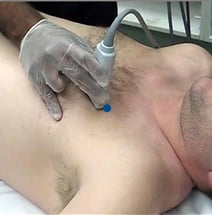Tracheal Ultrasonography and Ultrasonographic Lung Sliding for Confirming Endotracheal Tube Placement: Speed and Reliability

SONOSIM SUMMARY: This observational study evaluated the use of ultrasound to differentiate between esophageal versus tracheal intubation in patients who received either emergency intubation during CPR or rapid sequence intubation. Current techniques for ruling out endoesophageal placement include measuring end-tidal carbon dioxide levels. In this study, ultrasonography was used to both visualize the endotracheal tube within the trachea as well as confirm lung sliding. Findings suggest that ultrasonography is faster than measuring end-tidal carbon dioxide levels and is otherwise as effective as capnography for assessing endotracheal tube placement.
Karacabey, S., Sanri, E., Gencer, E. G., & Guneysel, O. (2016). Tracheal ultrasonography and ultrasonographic lung sliding for confirming endotracheal tube placement: Speed and reliability. The American Journal of Emergency Medicine, 34(6), 953-956. doi:http://dx.doi.org.libproxy1.usc.edu/10.1016/j.ajem.2016.01.027
Abstract
Background
In this study, we aimed to evaluate the success of ultrasonography (USG) in confirming the tube placement and timeliness of tracheal USG and ultrasonographic lung sliding in resuscitation and rapid sequence intubation.
Methods
This study was a prospective, single-center, observational study conducted in the emergency department of a tertiary care hospital. Patients were prospectively enrolled in the study. Patients who went under emergency intubation because of respiratory failure, cardiac arrest, or severe trauma were included in the study. Patients with severe neck trauma, neck tumors, history of neck operation or tracheotomy, and under 18 years old were excluded from the study.
Results
A total of 115 patients were included in the study. The mean age was 67.2±17.1 with ages 16-95years old. Among 115 patients 30 were cardiac arrest patients other 85 patients were non-cardiac arrest patients intubated with rapid sequence intubation. The overall accuracy of the ultrasonography was 97.18% (95% CI, 90.19-99.66%), and the value of kappa was 0.869 (95% CI, 0.77-0.96), indicating a high degree of agreement between the ultrasonography and capnography. The ultrasonography [sic] took significantly less time than capnography in total.
Conclusions
Ultrasonography achieved high sensitivity and specificity for confirming tube placement and results faster than end-tidal carbon dioxide. Ultrasonography is a good alternative for confirming endotracheal tube placement. Future studies should examine the use of ultrasonography as a method for real-time assessment of endotracheal tube placement by emergency physicians with only basic ultrasonographic training.
To read the article, visit the American Journal of Emergency Medicine
SonoSim Keywords: Tracheal Ultrasonography, Ultrasound, Ultrasonographic Lung Sliding, Endotracheal Tube